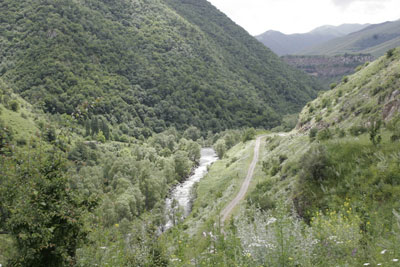Re: Stories of Armenian repatriates
"I'LL COME TO LIVE IN ARMENIA," MANY OF FIRST PARTICIPANTS OF COME HOME PROGRAM SAY
Noyan Tapan
July 24, 2009
YEREVAN, JULY 24, NOYAN TAPAN - ARMENIANS TODAY. Young Sargis who has
left Syria for Armenia within the framework of the Come Home program
of the RA Ministry of Diaspora decided again to return Armenia in two
months and permanently settle in Armenia. In any case, he told the
Noyan Tapan correspondent about it. In Sargis' words, it is already
his second visit to Armenia, but he sees great difference between
those two visits. "When I first came to Armenia, it was a more Soviet
country, it has greatly changed to good now," Sargis said.
Sargis likes architecture in Armenia in which he sees reflection of
the Armenian soul. He likes the people's warm attitude, hospitality
and does no like the indefferent attitude of inhabitants of Armenia
towards cultural values: "It is minor for them," he mentioned with
pain. In Sargis' words, it is also bad that young people from Armenia
smoke heavily.
Tamar from Turkey also expressed a great wish for living in Armenia,
though, as she mentioned, the number of people assisting Armenians
increased in Turkey.
Anahit from Georgia is also among the participants of the Come Home
program.
Though she is already for the fourth time in Armenia, but in her wrods,
she this time as well found Armenia changed: Yerevan has changed,
it became beautiful, people's clothes changed. "Armenia develops,
and it makes me happy," Anahit said. She also has a goal to move to
Armenia for permanent residence.
To recap, Diasporan Armenian young people at the age of 18-25 arrived
in Armenia within the framework of the Come Home program implemented
by the RA Ministry of Diaspora. They live in families which are
inhabitants of Armenia, closer get acquainted with the life of the
Homeland, deepen their knowledge about the Armenian culture, history
and other national values. The first group of young people arrived in
Armenia a week ago has already visited places of interest of Armenia,
has been in Matenadaran, History Museum of Armenia, had a meeting with
YSU Rector Aram Simonian, RA Minister of Diaspora, learned Armenian
dances. A group of them even visited one of military units of the
Armenian Army.
"I'LL COME TO LIVE IN ARMENIA," MANY OF FIRST PARTICIPANTS OF COME HOME PROGRAM SAY
Noyan Tapan
July 24, 2009
YEREVAN, JULY 24, NOYAN TAPAN - ARMENIANS TODAY. Young Sargis who has
left Syria for Armenia within the framework of the Come Home program
of the RA Ministry of Diaspora decided again to return Armenia in two
months and permanently settle in Armenia. In any case, he told the
Noyan Tapan correspondent about it. In Sargis' words, it is already
his second visit to Armenia, but he sees great difference between
those two visits. "When I first came to Armenia, it was a more Soviet
country, it has greatly changed to good now," Sargis said.
Sargis likes architecture in Armenia in which he sees reflection of
the Armenian soul. He likes the people's warm attitude, hospitality
and does no like the indefferent attitude of inhabitants of Armenia
towards cultural values: "It is minor for them," he mentioned with
pain. In Sargis' words, it is also bad that young people from Armenia
smoke heavily.
Tamar from Turkey also expressed a great wish for living in Armenia,
though, as she mentioned, the number of people assisting Armenians
increased in Turkey.
Anahit from Georgia is also among the participants of the Come Home
program.
Though she is already for the fourth time in Armenia, but in her wrods,
she this time as well found Armenia changed: Yerevan has changed,
it became beautiful, people's clothes changed. "Armenia develops,
and it makes me happy," Anahit said. She also has a goal to move to
Armenia for permanent residence.
To recap, Diasporan Armenian young people at the age of 18-25 arrived
in Armenia within the framework of the Come Home program implemented
by the RA Ministry of Diaspora. They live in families which are
inhabitants of Armenia, closer get acquainted with the life of the
Homeland, deepen their knowledge about the Armenian culture, history
and other national values. The first group of young people arrived in
Armenia a week ago has already visited places of interest of Armenia,
has been in Matenadaran, History Museum of Armenia, had a meeting with
YSU Rector Aram Simonian, RA Minister of Diaspora, learned Armenian
dances. A group of them even visited one of military units of the
Armenian Army.













Comment